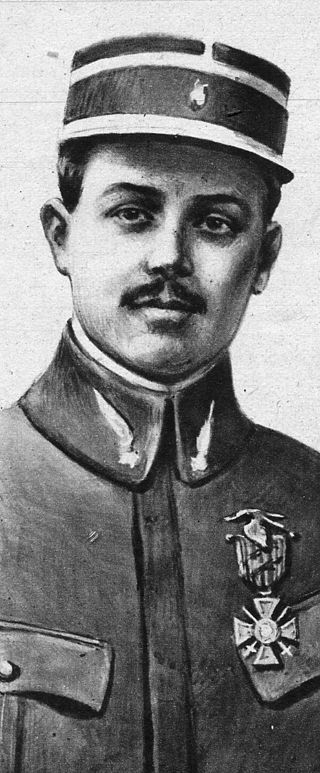Related Research Articles

General Joseph Vuillemin was a French professional soldier whose early interest in aviation led him into increasingly responsible leadership positions in the Aeronautique Militaire during World War I. Ending the war with extensive decorations, including an unusual double award of the Legion d'honneur, as well as seven aerial victories, he became a dynamic leader of an aerial expedition to Africa in 1933. His climb through the ranks continued until World War II, when he became Chief of Staff of the French Air Force during the first year of World War II.

Colonel Marcel Émile Haegelen, Légion d'honneur, Médaille militaire, Croix de Guerre, was a World War I French flying ace credited with 22 victories.
Capitaine Paul Louis Malavialle was a French World War I flying ace credited with five aerial victories.
Sous lieutenantLouis Georges Robert Risacher was a French World War I flying ace credited with five aerial victories. He would return to his nation's service during World War II.
CapitainePierre Armand Wertheim, alias Pierre Armand Wertheimer, was a French World War I flying ace credited with five aerial victories.
Captain Gustave Naudin was a French World War I flying ace credited with six aerial victories. He returned to his nation's defense during World War II, serving as an infantry officer.

Sous-LieutenantFrançois Marie Joseph Laurent Victurnien de Rochechouart de Mortemart,, Marquis of Mortemart, Prince of Tonnay-Charente, was a French World War I flying ace credited with seven aerial victories.
Lieutenant Alexandre Paul Leon Madeleine Marty was a French World War I flying ace credited with seven aerial victories.
CapitaineGabriel Joseph Thomas was a World War I flying ace credited with seven aerial victories.
CapitaineRoger Poupon was a French World War I flying ace credited with eight aerial victories.
Chef de BataillonRobert Leon Henri Massenet-Royer de Marancour was a French World War I flying ace credited with eight aerial victories.

Capitaine Albert Louis Deullin was a French World War I flying ace credited with twenty aerial victories. He served for the entirety of World War I. By war's end, he had risen to command of a fighter wing. He would die in a postwar flying accident.

Capitaine Mathieu Marie Joseph Antoine Tenant de la Tour was a French World War I flying ace credited with nine aerial victories. He scored one of the first aerial victories over an observation balloon.
Capitaine Gustave Victorin Daladier was a French World War I flying ace credited with twelve aerial victories. He would continue in his nation's military service after World War I.
Major Adrien Louis Jacques Leps was a French World War I flying ace credited with twelve confirmed aerial victories, as well as two probables. He served originally in the cavalry, before shifting to flying. In later years, he served under General Armand Pinsard during World War II.

Sous Lieutenant Paul Yvan Robert Waddington was a French World War I flying ace credited with twelve aerial victories.
Capitaine Henri Albert Péronneau was a World War I flying ace credited with nine confirmed aerial victories. He served his nation for more than four decades.
Charles Eugene Joseph Marie Lefevre (1893-1948) was a French flying ace credited with six aerial victories during the First World War. He led two different fighter squadrons into combat to do so, and won the Legion d'honneur for his exploits.

Albert Edmond Mezergues was a French professional soldier who became a flying ace during World War I by scoring six aerial victories. Highly decorated during the war, he continued in military service postwar until his death in 1925.
CapitaineJacques Victor Sabattier de Vignolle was a reservist officer of the French Army called to the colors during the First World War. While serving in a succession of increasingly important commands, he also flew a SPAD fighter to shoot down five German airplanes and become a flying ace. Thrice wounded, he ended the war commanding an air wing.
References
- Franks, Norman; Bailey, Frank (1993). Over the Front: The Complete Record of the Fighter Aces and Units of the United States and French Air Services, 1914–1918 London, UK: Grub Street Publishing. ISBN 978-0-948817-54-0.